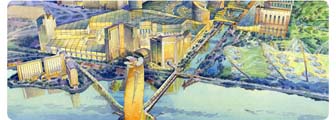Note: I received email from Joel this afternoon noting that his time at the Aspen Ideas Conference has been "an intense six days," and he asked me to use one of his writings from Two Steps Forward for his contribution. I'm more than happy to reprint his post from July 4, 2005.
My friend Amanda Griscom Little’s piece in Sunday’s New York Times Magazine about Destiny USA offered a glimpse into this mega-green project: a $20 billion retail-and-entertainment development in upstate New York with big-time renewable energy ambitions.
But it only begins to tell the story.
 My colleagues at GreenOrder, the New York-based consultancy that recently helped GE bring Ecomagination to the world, have been working with Destiny’s developers since late last year, helping them develop and implement the project’s bold green strategy. As I’ve watched Destiny USA unfold firsthand, it’s become clear that this is not your basic “green development”: Nearly everything about the project seems outsized and implausible. And just about everyone involved has at first viewed this project askance, questioning whether shopping center developer Robert Congel could pull off his audacious green goals.
My colleagues at GreenOrder, the New York-based consultancy that recently helped GE bring Ecomagination to the world, have been working with Destiny’s developers since late last year, helping them develop and implement the project’s bold green strategy. As I’ve watched Destiny USA unfold firsthand, it’s become clear that this is not your basic “green development”: Nearly everything about the project seems outsized and implausible. And just about everyone involved has at first viewed this project askance, questioning whether shopping center developer Robert Congel could pull off his audacious green goals.
I can attest that it’s all very real.
Little’s NYT piece captured part of the project’s essence. Congel intends that renewable energy alone will power Destiny’s hundreds of shops and restaurants, tens of thousands of hotel rooms, and sizeable entertainment and sports venues. As the Times article describes, Congel’s green vision to make his 200-acre development fossil-fuel free stemmed from an epiphany about America’s oil addiction following a visit to the D-Day beaches in Normandy soon after 9/11.
What the Times piece doesn’t make clear is that Destiny has gone well beyond the vision stage. The project is just now breaking ground on the first phase of development and Destiny is currently making deals with solar, wind, and biomass companies that will bring several megawatts of renewable power and clean-tech jobs to upstate New York.
 And Destiny’s green plans go beyond energy to include design and construction of the buildings and grounds; the transportation systems within the development; and the food, dining, and hospitality services. There’s also a plan to develop an extensive clean-air transit system to bring visitors to Destiny (addressing one of the few concerns expressed by environmentalists in the Times piece). In short: Every part of the Destiny experience is meant to create environmental awareness that visitors will take home with them.
And Destiny’s green plans go beyond energy to include design and construction of the buildings and grounds; the transportation systems within the development; and the food, dining, and hospitality services. There’s also a plan to develop an extensive clean-air transit system to bring visitors to Destiny (addressing one of the few concerns expressed by environmentalists in the Times piece). In short: Every part of the Destiny experience is meant to create environmental awareness that visitors will take home with them.
But there’s more here than just education. Congel and company hope to make Destiny a test bed for innovative clean technologies -- and to showcase them to the world. Congel sees Destiny as an incubator for technologies and companies that will help make upstate New York a hotbed for renewable energy, biofuels, sustainable agriculture, and green transportation.
Will it all work? It’s too soon to tell. Nothing like this has been done before, which makes Destiny something of an environmental high-wire act. But, to cite one of Destiny’s self-governing principles, “Green is a journey, not a destination.” I’m looking forward to tagging along on this journey, being helpful where I can -- and sharing it all with you. Stay tuned.
Another note: Joel's not the only one thinking on his blog about Destiny USA. WorldChanging's Alex Steffen and Syracuse resident Steve Balogh have also blogged on this monumental undertaking.
Technorati tags: renewable energy, green building, sustainable development, Syracuse
Green is the New Black: Vivavi